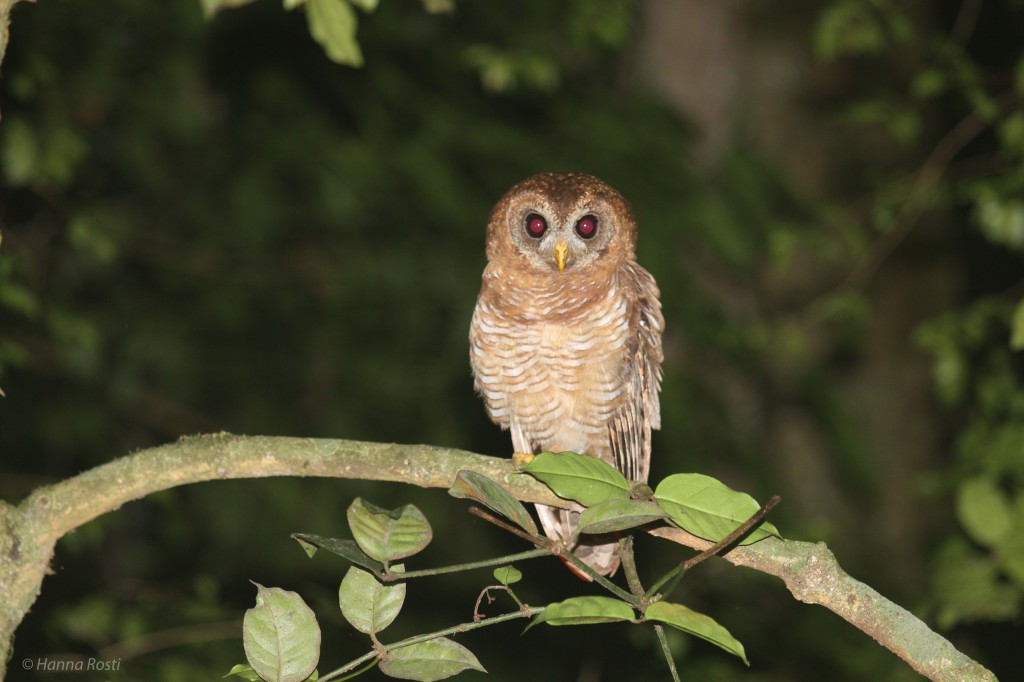
In Taita Hills of Kenya African wood owl (Strix woodfordii) is quite common. Owl couple keep contact with each other by calling. Interestingly male and female can counter call with similar calls, or female may use different call.

Counter calling of African wood owl couple from Taita Hills.
Male makes a series of rapid, clear hoots, and the female answers with higher pitched, more leisurely hoots.

Different call of a female African wood owl from Taita Hills

African wood owls in Taita Hills are about the size of the crow, 30-35 cm, weighing 240-350 grams. African wood owl eats mainly insects.

They can’t see red flashlight, which has enabled me to watch them without them without owls paying any attention for me.

Mainly insectivorous, however they also catch small mammals… In Taita Hills African wood owls hunt also Taita mountain dwarf galagos that are almost extinct. For dwarf galagos this owl may be the ultimate reason for extinction.

Reason for extremely low population numbers in dwarf galagos is loss of habitat, as forests have been cleared for fields. However, in these small remaining patches of forest, the probability of dwarf galago being hunted by wood owl increases. They share same territories every night. Dwarf galagos are dependent on refugee sites in hollow trees. Only very old trees are have hollows or are completely hollow.
Distribution and conservation status
African wood owl has extremely large distribution in Africa. Conservation status is Least Concern LC. Populations seem to be stable. However there is no long term research about the species


Geographic range from Avibase with four subspecies: These subspecies have considerable differences in their coloration.
- Strix woodfordii woodfordii: southern Angola to southern Democratic Republic of the Congo, southwestern Tanzania, Botswana, and South Africa
- Strix woodfordii nuchalis: Senegambia and Bioko Island to South Sudan, Uganda, western Democratic Republic of the Congo, and northern Angola
- Strix woodfordii umbrina: Ethiopia and eastern South Sudan
- Strix woodfordii nigricantior: southern Somalia to Kenya, Tanzania, Zanzibar, and eastern Democratic Republic of the Congo

Taxonomy
Genus Strix was created by Linnaeus 1758 for earless owls. Strix owls do not have ear tufts. There are 22 species of genus Strix in the world. They are medium to large in size and live in forests. Strix owls are found around the world. African wood owl has four subspecies as described earlier.


Sources:
Birdlife African wood owl: http://datazone.birdlife.org/species/factsheet/african-wood-owl-strix-woodfordii
Avibase African wood owl: https://avibase.bsc-eoc.org/species.jsp?lang=FI&avibaseid=2E6575A8C8ECAD9B&sec=summary
Iucn Red Lis Assessment: https://www.iucnredlist.org/species/22689166/93220349#population
BirdLife International. 2016. Strix woodfordii. The IUCN Red List of Threatened Species 2016: e.T22689166A93220349. https://dx.doi.org/10.2305/IUCN.UK.2016-3.RLTS.T22689166A93220349.en. Downloaded on 08 May 2020.








Leave a comment